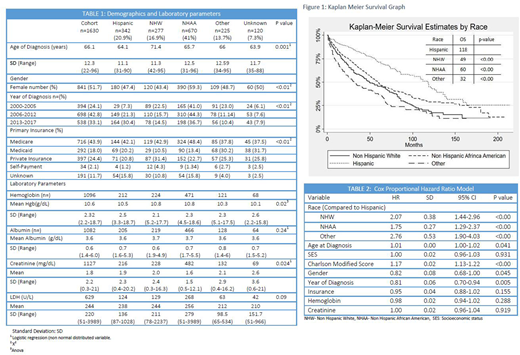Abstract
Background:
Multiple Myeloma (MM) represents 1.8% of all new cancers in the United States and is the second most common hematologic malignancy in the US with 30,000 new cases/year. The highest incidence is amongst African Americans (AA) (SEER, 2018). Increased use of autologous stem cell transplant (AHSCT) as well as introduction of proteasome inhibitors (PIs) and immunomodulatory agents (iMiDs) have led to an improvement in overall survival (OS) from 35.6% between 1998-2001 to 50.7% in 2008-2014 (Child et al. 2003; Pulte et al. 2014).
Despite these improvements, outcomes in MM are heterogeneous and are influenced by sociodemographic factors like race and ethnicity, disease biology (laboratory markers, cytogenetics) and access to transplantation (Al-Hamadani, Hashmi, and Go 2014; Ailawadhi et al. 2016). Several large population-based studies report that Hispanics have low stem cell utilization rates, limited access to novel therapeutics and clinical trials as well (Ailawadhi et al. 2018; Costa et al. 2015; Schriber et al. 2017; Pulte et al. 2014). Hence, outcomes for Hispanics and AA lag behind non-Hispanic Whites as well (Pulte et al. 2014).
We wanted to evaluate outcomes of MM patients at Montefiore Medical Center where AA and Hispanics have access to novel agents and therapeutics, and most of whom hail from a poor socio-economic status.
Methods:
We obtained a cohort of patients diagnosed with MM between 1/1/2000-12/31/2017 from the Montefiore Medical Center Cancer Registry database via Clinical Looking Glass software. Socio-demographic characteristics including self-reported ethnicity, date of diagnosis, histology, laboratory parameters (hemoglobin (Hgb), creatinine (Cr), albumin (Alb), serum lactate dehydrogenase (LDH)) within 30 days of diagnosis were obtained. Ethnicity and race variables were condensed to Hispanics, Non-Hispanic Whites (NHW) and Non-Hispanic African Americans (NHAA). Charlson comorbidity score and its age-adjusted version were calculated. Primary payor (Medicaid, Medicare, private insurance or self-pay) was identified for each patient. Descriptive statistical analysis was performed using STATA 15.1 statistical software. OS was estimated using the Kaplan-Meier method and HR and corresponding 95% confidence intervals (CI) were estimated using the cox proportional hazard model. All the variables in the Cox proportional hazard ratio model fulfill the proportional hazard assumption.
Results:
We identified 1630 patients during the study period; 1502 patients were available for analysis (Table 1) The mean age of diagnosis was 66 years, and NWH were diagnosed at older age when compared to Hispanics or NHAA (71 vs 64 vs 66, p=0.001) respectively. Hispanics had a higher proportion of Medicaid affiliation. The baseline mean Hb (p=0.02), Cr (p=0.02) and LDH (p=0.09) were different; however this difference is unlikely to be clinically relevant (Table 1).
Median survival for the cohort was 63 months (95% CI: 59-69). Hispanics had better mean OS (118 months, (95% CI 96-128) as compared to NHW (49 months, 95% CI 40-68)) and NHAA (60 months, 95% CI 53-66) and others (32 months, 95% CI 21-46) (Figure 1). After controlling for age at diagnosis, gender, socioeconomic status, modified Charlson age score, race had a statistically significant impact on the outcome, with NHW (HR-2.01) and NHAA (HR 1.77) having poorer survival when compared to Hispanics (P<0.001). The results did not change after excluding the unknown group. Increasing age, Charlson score, earlier time period of diagnosis and male sex were independently associated with death (Table 2). Primary payor was not independently associated with worse outcomes.
Conclusion
The study cohort is significantly different to prior reports, with a higher rate of NHAA and Hispanics. Hispanics had a higher percentage of Medicaid as primary payor. Contrary to prior reports, we show that with access to novel agents and transplantation, MM in Hispanics has a better OS than AA and NHW. We also show that NHAA (41%) despite being diagnosed at a younger age than NHW continue to have poorer outcomes than Hispanics. Further characterization including risk stratification and cytogenetics is underway to identify factors leading to better and worse outcome in Hispanics and AA respectively.
Janakiram:Seattle Genetics: Membership on an entity's Board of Directors or advisory committees.
Author notes
Asterisk with author names denotes non-ASH members.


This feature is available to Subscribers Only
Sign In or Create an Account Close Modal